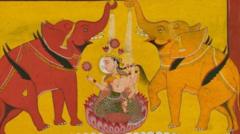A new exhibition at the British Museum, titled "Ancient India: Living Traditions," unveils the captivating evolution of spiritual art in India, featuring 189 remarkable objects that span centuries. Visitors have the chance to explore a variety of artworks including ancient sculptures, paintings, and intricate manuscripts, revealing a rich tapestry of spiritual expression from 200 BC to AD 600.
Throughout this transformative period, the representation of deities in Hinduism, Buddhism, and Jainism evolved from symbolic forms to more human-like portrayals. "Today, we can’t imagine worship without human forms," notes curator Sushma Jansari, highlighting the fascinating transition in religious iconography that remains relevant today.
The exhibition is organized into five sections, beginning with nature spirits and culminating in the global spread of these faiths. This unique presentation combines artistry from various regions, including striking sculptures from Mathura, offering insight into the intertwined traditions of all three religions.
Of particular interest is a two-sided sandstone panel that depicts the evolution of the figure of the Buddha, contrasting his symbolic representation with a human incarnation. Other highlights include statues that illustrate the gradual change in Hindu artistic expression and Jain artworks focusing on the 24 tirthankaras.
Notably, the exhibition sheds light on the contributions of women in the creation and donation of Buddhist art, presenting an engaging atmosphere with sensory elements designed to evoke the essence of religious shrines. Through a blend of history and contemporary practice, the exhibition emphasizes the ongoing relevance of these artistic traditions, showcasing how they resonate with millions today. "Ancient India: Living Traditions" runs at the British Museum from May 22 to October 19.



















